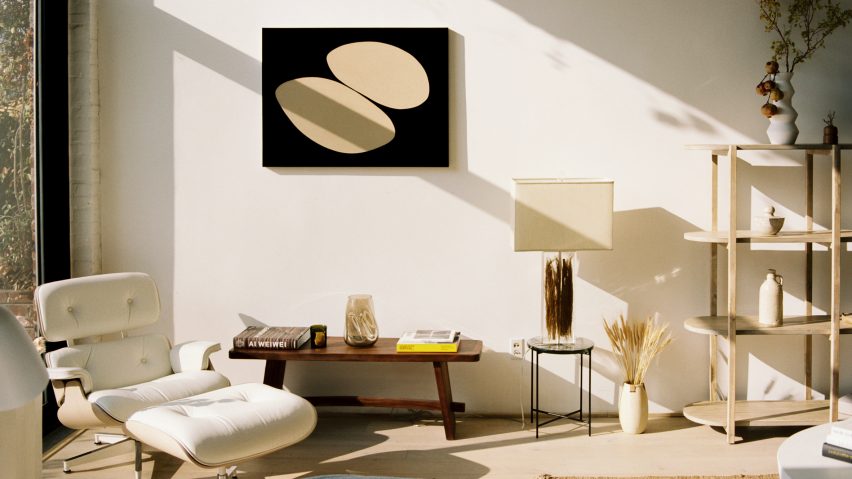Pieces by Le Corbusier, Charlotte Perriand, and Charles and Ray Eames are included in this roundup of modernist furniture designed by architects working in the 20th century.
Many of the architects whose work is featured below turned their hand to furniture design after training in architecture.
For some, it was a career change, while others treated it as an addition to their architecture work, opting to design some of the furnishings for the homes they were building.
After making an impact on 20th-century design, some of the furniture pieces are still in production and recognisable today, while others have influenced contemporary designers and manufacturers to reinterpret them for modern-day customers.
Read on for 12 furniture designs by 20th-century architects:
E1027 side table by Eileen Gray (1927)
Designed by Irish architect Eileen Gray as a multifunctional table that could be used in living spaces and by the bedside, E1027 comprises two circular metal tubes held together by a metal stand.
The table was created for the modernist E-1027 villa on the south coast of France, which was completed in 1929 as Gray's first major architecture project.
LC4 Chaise Lounge by Le Corbusier, Pierre Jeanneret and Charlotte Perriand (1928)
French-Swiss architect Le Corbusier worked with his cousin and fellow architect Pierre Jeanneret and Perriand on multiple recognisable furniture designs.
Pictured above in a home in Wyoming is the LC4 Chaise Lounge, which was designed by the trio to follow the natural contours of the human body.
Cesca Chair by Marcel Breuer (1928)
Hungarian-American architect Marcel Breuer designed the cantilevered Cesca Chair in 1928 with a tubular steel frame and a rattan seat and backrest.
GRT Architects furnished a Manhattan restaurant and cocktail bar with upholstered versions of the Cesca Chair, which furniture brand Knoll has produced since 1968.
Barcelona Chair by Mies van der Rohe and Lilly Reich (1929)
Designed by Mies van der Rohe in 1929 with his long-term partner and fellow architect Lilly Reich, the Barcelona Chair is considered an iconic piece of furniture from the modernist movement.
Pictured above is the chair with its matching stool at the Mass is More installation at the Barcelona Pavilion, a home also designed by Mies van der Rohe.
Find out more about Barcelona Chair ›
Stool 60 by Alvar Aalto (1933)
Stool 60 was created by Finnish architect and designer Alvar Aalto in 1933 with a simple, flat-packed design made up of a circular seat and three legs.
Architect Daisuke Motogi took the iconic stool and reinterpreted it into one hundred different iterations for the Hackability of the Stool exhibition (pictured above), including designs where the stool became a chess board, loo roll holder, drying rack and vinyl record player.
Find out more about Hackability of the Stool ›
Racine Collection by Frank Lloyd Wright and Steelcase (1939)
American company Steelcase used archival designs by architect Wright to create the Racine Collection of furniture, which includes desks and office chairs.
Steelcase looked to furniture designed by Wright for his SC Johnson Administration building, completed in 1939 and located in the town of Racine, Wisconsin.
As part of Dezeen's review of 2023, our readers named the Racine Collection the best furniture design of the year.
Find out more about the Racine Collection ›
Ball Chair by Lina Bo Bardi (1951)
Defined by its encompassing semi-spherical seat that can be rotated to different angles, the Ball Chair by Italian-Brazilian architect Lina Bo Bardi is supported by a metal ring on four legs.
Designed by Bo Bardi in 1951, the chair was relaunched by Italian design brand Arper in 2014 in a range of upholstery options, including black leather and various colourful fabrics.
Find out more about Ball Chair ›
Florence Knoll Sofa by Florence Knoll Bassett (1954)
Florence Knoll Bassett – who trained as an architect before founding the furniture brand Knoll Associates with her husband Hans Knoll – designed multiple pieces of furniture for her brand.
Knoll, who died in 2019, described her designs as the "bread and butter" of the brand, including the Florence Knoll Sofa pictured above. The pieces were sold alongside sculptural designs by other modernist designers.
Eames Lounge Chair by Charles and Ray Eames (1956)
American husband and wife duo Charles and Ray Eames designed a lounge chair with an accompanying ottoman in 1956 made from moulded plywood, a production method the Eameses had been pioneering since the early 1940s.
Pictured above is the Eames Lounge Chair and ottoman in a Los Angeles apartment that architecture and design studio OWIU Studio updated with beige-toned furniture and materials.
Find out more about Eames Lounge Chair ›
Egg chair by Arne Jacobsen (1958)
Created by Danish architect Arne Jacobsen in 1958 for the interior of the SAS Royal Hotel in Copenhagen, the Egg chair is made by glueing leather or textile onto polyurethane foam, which is then moulded over a metal or fibreglass structural frame.
In a statement to Dezeen, design studio Pearson Lloyd founders Luke Pearson and Tom Lloyd claimed the concave chair would not be designed today as the amount of glue needed in its production makes it too difficult to recycle.
Wiggle Chair by Frank Gehry (1972)
Utilising the materials he typically used to make architectural models, architect Frank Gehry combined 60 layers of corrugated cardboard to create the sculptural Wiggle Chair in 1972.
Dutch interior design practice DAB Studio added the rounded chair to the transformation of a kitchen in a family home in the Netherlands to balance the space's rectangular forms.
Find out more about Wiggle Chair ›
Ventaglio table by Charlotte Perriand (1972)
After working on furniture with Le Corbusier between 1927 and 1937, Perriand pursued a solo career. Her designs were heavily influenced by nature and her time spent in Japan during the second world war.
In 1972 she designed the Ventaglio oak table with a geometric tabletop, which is currently manufactured by Italian furniture brand Cassina.
Find out more about Ventaglio ›

